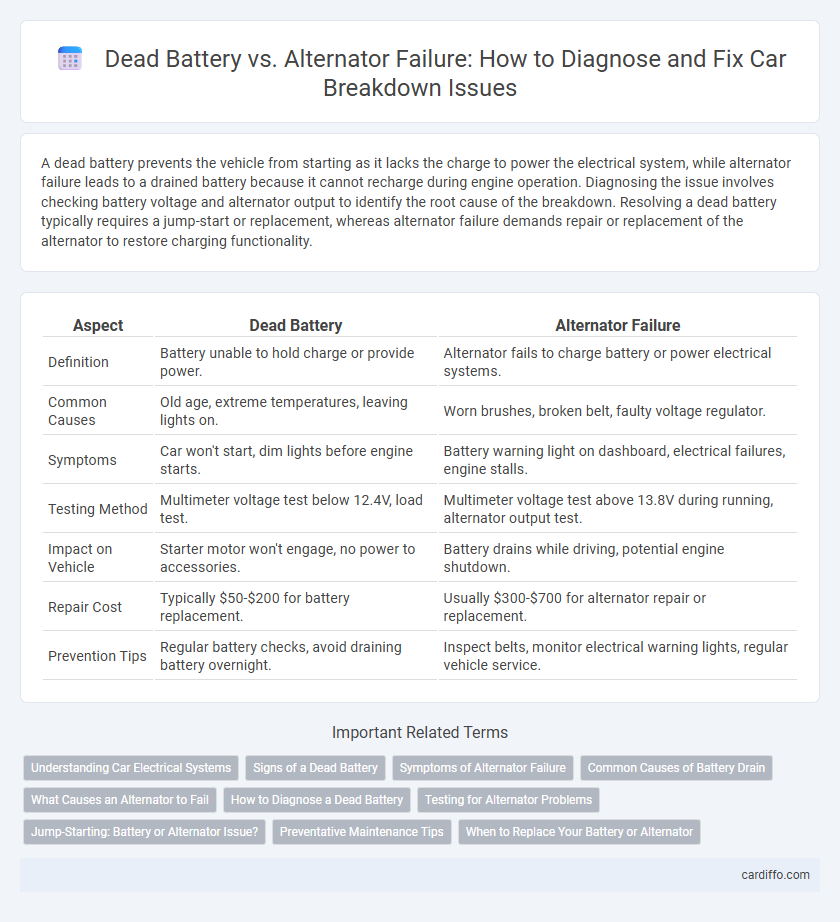A dead battery prevents the vehicle from starting as it lacks the charge to power the electrical system, while alternator failure leads to a drained battery because it cannot recharge during engine operation. Diagnosing the issue involves checking battery voltage and alternator output to identify the root cause of the breakdown. Resolving a dead battery typically requires a jump-start or replacement, whereas alternator failure demands repair or replacement of the alternator to restore charging functionality.
Table of Comparison
| Aspect | Dead Battery | Alternator Failure |
|---|---|---|
| Definition | Battery unable to hold charge or provide power. | Alternator fails to charge battery or power electrical systems. |
| Common Causes | Old age, extreme temperatures, leaving lights on. | Worn brushes, broken belt, faulty voltage regulator. |
| Symptoms | Car won't start, dim lights before engine starts. | Battery warning light on dashboard, electrical failures, engine stalls. |
| Testing Method | Multimeter voltage test below 12.4V, load test. | Multimeter voltage test above 13.8V during running, alternator output test. |
| Impact on Vehicle | Starter motor won't engage, no power to accessories. | Battery drains while driving, potential engine shutdown. |
| Repair Cost | Typically $50-$200 for battery replacement. | Usually $300-$700 for alternator repair or replacement. |
| Prevention Tips | Regular battery checks, avoid draining battery overnight. | Inspect belts, monitor electrical warning lights, regular vehicle service. |
Understanding Car Electrical Systems
A dead battery typically results from insufficient charge or age-related degradation, preventing the vehicle from starting, while alternator failure causes the battery to not recharge during operation, leading to a gradual power loss. Understanding car electrical systems reveals that the alternator converts mechanical energy into electrical energy to maintain battery voltage and power electronic components. Proper diagnosis requires testing both the battery's voltage and the alternator's output to distinguish between a simple jump-start solution and a more complex electrical repair.
Signs of a Dead Battery
Signs of a dead battery include slow engine cranking, dim headlights, and electrical issues such as malfunctioning power windows or dashboard lights. Frequent jump-starts and a battery warning light on the dashboard often indicate a battery failing to hold a charge. Testing with a multimeter typically reveals a voltage below 12.4 volts, confirming a dead or weak battery.
Symptoms of Alternator Failure
Symptoms of alternator failure include dim or flickering headlights, a warning battery light on the dashboard, and electrical issues such as malfunctioning power windows or radio. The engine may stall or have difficulty starting due to insufficient charging of the battery. Unusual noises like grinding or whining can also indicate alternator problems requiring immediate attention.
Common Causes of Battery Drain
Common causes of battery drain include leaving lights or electronic devices on, faulty wiring, and parasitic draws from accessories such as alarms or infotainment systems. A dead battery often results from prolonged exposure to cold temperatures or an aging battery that cannot hold a charge effectively. Alternator failure contributes indirectly by failing to recharge the battery while the engine runs, accelerating battery depletion and eventual breakdown.
What Causes an Alternator to Fail
An alternator fails primarily due to worn-out bearings, a faulty voltage regulator, or damaged diodes that disrupt its ability to charge the battery effectively. Excessive heat, oil leaks, and exposure to road debris accelerate the deterioration of internal components, leading to alternator malfunction. Ignoring warning signs such as dimming headlights or battery warning lights further increases the risk of complete alternator failure.
How to Diagnose a Dead Battery
To diagnose a dead battery, start by checking the voltage with a multimeter; a healthy battery typically reads around 12.6 volts when fully charged. If the voltage is below 12.4 volts, try jump-starting the vehicle and observe if it starts and runs properly. Persistent starting issues despite a jump-start may indicate alternator failure rather than a dead battery.
Testing for Alternator Problems
Testing for alternator problems involves measuring the voltage output with a multimeter, where a healthy alternator typically produces between 13.8 and 14.4 volts when the engine is running. A reading below this range can indicate alternator failure rather than a dead battery, especially if the battery is fully charged but the vehicle still experiences electrical issues. Checking the alternator belt for tension and any unusual noises during engine operation also helps diagnose alternator problems accurately.
Jump-Starting: Battery or Alternator Issue?
Jump-starting a vehicle typically resolves issues related to a dead battery by providing the necessary power to start the engine. If the car starts but then dies shortly after, this often indicates alternator failure, as the alternator is responsible for recharging the battery and powering electrical systems while the engine runs. Testing the battery voltage before and after jump-starting can help differentiate between a battery problem and alternator malfunction.
Preventative Maintenance Tips
Regularly inspecting the battery terminals and cleaning any corrosion helps prevent dead battery issues, while testing the alternator's voltage output ensures it provides consistent power to the vehicle's electrical system. Replacing the battery every 3-5 years and scheduling professional alternator tests during routine vehicle maintenance can significantly reduce the risk of breakdowns caused by electrical failures. Using a multimeter to monitor battery health and alternator performance periodically identifies potential problems before they become critical.
When to Replace Your Battery or Alternator
A dead battery typically requires replacement when it fails to hold a charge after multiple jump-start attempts or shows signs of corrosion and swelling. Alternator failure demands replacement if the battery repeatedly drains despite being charged or if dashboard warning lights, such as the battery or charging system indicator, illuminate. Diagnosing the issue early with voltage tests can prevent further vehicle breakdown and costly repairs.
Dead battery vs alternator failure Infographic

 cardiffo.com
cardiffo.com